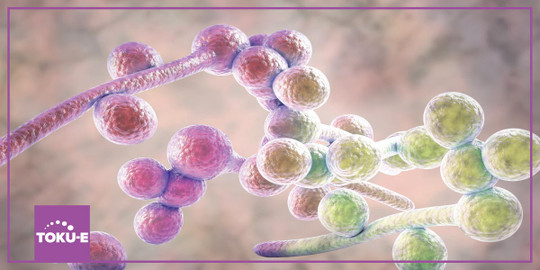The body is a host to a variety of microbial communities. Our microbiota influences everything from digestion to behavior and is more and more evident that these microbiota are a fundamental component of our body physiology. A growing number of studies reveal the importance of fungi, and despite being a smaller component of this community, our ‘mycobiota’ (the fungal communities in the body), is significant. These fungi compete with each other and with the other resident bacteria for resources. The immune system’s job is to maintain a healthy relationship with these microbiota roomies.
Did you know our mouth is home to >75 fungal genera, with Candida, Cladosporium, Aureobasidium, Aspergillus and Fusarium being most common? Our skin has unique fungal microbiota, with the commensal fungus Malassezia being the most common, followed by Penicillium and Aspergillus. And our gut is home to over 50 different fungal, with Candida, Saccharomyces and Cladosporium being the most common. There is little evidence of commensal fungi in healthy lungs but when normal lung function is compromised, such as in cystic fibrosis, fungal communities may take hold. Common fungi include Aspergillus and Scedosporium. Normally, alveolar macrophages find, internalize, and kill these spores, since spores that evade killing can grow into hyphae which can invade the tissue. We know little about if or how intestinal commensal fungi interact with our immune system., but we do know that immune cells use a variety of receptors to recognize these fungi.
Two recent studies in Cell found that fungi were associated with human tumors. This means that distinct mycobiota signatures could in fact predict human cancers. The finding was a surprise to researchers at UCSD and fungi were detected in 35 different cancer types in over 17,000 patient samples. There were differences in fungal communities among cancer types, even when accounting for technical background. Histological staining found intratumoral presence and frequent spatial association with cancer cells and macrophages. The study at Cornell University jointly with Duke University, analyzed several types of cancers and detected up to one fungal cell for every 10,000 cancer cells. Active Candida species were found in colon and stomach cancers, Blastomyces in lung tumors, and Malassezia species in breast tumors. This data is exciting because it lays the foundation for simple tests for Candida DNA for gastrointestinal cancers which could augment standard tumor biopsies. Their hypothesis is that tumor tissues are a substantial source of blood-derived fungal DNA. This means there could be a way to use cell-free microbial DNA itself as a minimally invasive diagnostic marker for cancer.
References
Dohlman A et al (2022) A pan-cancer mycobiome analysis reveals fungal involvement in gastrointestinal and lung tumors. Cell 185(20):3807-3822
Narunsky L et al (2022) Pan-cancer analyses reveal cancer-type-specific fungal ecologies and bacteriome interactions. Cell 185(20):3789-3806
Underhill DM and Iliev D (2014) The mycobiota: Interactions between commensal fungi and the host immune system. Nat. Rev. Immunol 14(6):405-416

